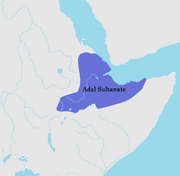
Flag of Adal Sultanate 1415 AD/CE to 1577 AD/CE
Capitals: Zeila, Dakkar, Harar, Aussa

Continent: Africa
Official Languages: Somali, Harari, Afar, Arabic
Established: 1415 AD/CE
Disestablished: 1577 AD/CE
History:
The Kingdom of Adal (also Awdal, Adl, or Adel) was centered around Zeila, its capital. It was established by the local Somali tribes in the early 9th century. Zeila attracted merchants from around the world, contributing to the wealth of the city. Zeila is an ancient city and it was one of the earliest cities in the world to embrace Islam.
In the late 9th century, Al-Yaqubi, an Armenian Muslim scholar and traveller, wrote that the Kingdom of Adal was a small wealthy kingdom and that Zeila served as the headquarters for the kingdom, which dated back to the beginning of the century.
According to the 16th-century explorer Leo Africanus, the Adal Sultanate's realm encompassed the geographical area between the Bab el Mandeb and Cape Guardafui. It was therefore flanked to the south by the Ajuran Empire (Kingdom of Ajuuran) and to the west by the Abyssinian Empire (Abassin Empire).
Adal is mentioned by name in the 14th century in the context of the battles between the Muslims of the Somali and Afar seaboard and the Abyssinian King Amda Seyon I's Christian troops. Adal originally had its capital in the port city of Zeila, situated in the northwestern Awdal region. The polity at the time was an Emirate in the larger Ifat Sultanate ruled by the Walashma dynasty.
In 1332, the King of Adal was slain in a military campaign aimed at halting Amda Seyon's march toward Zeila. When the last Sultan of Ifat, Sa'ad ad-Din II, was killed by Dawit I of Ethiopia at the port city of Zeila in 1410, his children escaped to Yemen, before later returning in 1415. In the early 15th century, Adal's capital was moved further inland to the town of Dakkar, where Sabr ad-Din II, the eldest son of Sa'ad ad-Din II, established a new Adal administration after his return from Yemen. During this period, Adal emerged as a center of Muslim resistance against the expanding Christian Abyssinian kingdom. Adal would thereafter govern all of the territory formerly ruled by the Ifat Sultanate, as well as the land further east all the way to Cape Guardafui, according to Leo Africanus.
After 1468, a new breed of rulers emerged on the Adal political scene. The dissidents opposed Walashma rule owing to a treaty that Sultan Muhammad ibn Badlay had signed with Emperor Baeda Maryam of Ethiopia, wherein Badlay agreed to submit yearly tribute. This was done to achieve peace in the region, though tribute was never sent. Adal's Emirs, who administered the provinces, interpreted the agreement as a betrayal of their independence and a retreat from the polity's longstanding policy of resistance to Abyssinian incursions. The main leader of this opposition was the Emir of Zeila, the Sultanate's richest province. As such, he was expected to pay the highest share of the annual tribute to be given to the Abyssinian Emperor. Emir Laday Usman subsequently marched to Dakkar and seized power in 1471. However, Usman did not dismiss the Sultan from office, but instead gave him a ceremonial position while retaining the real power for himself. Adal now came under the leadership of a powerful Emir who governed from the palace of a nominal Sultan.
Adalite armies under the leadership of rulers such as Sabr ad-Din II, Mansur ad-Din, Jamal ad-Din II, Shams ad-Din and general Mahfuz subsequently continued the struggle against Abyssinian expansionism.
Emir Mahfuz, who would fight with successive emperors, caused the death of Emperor Na'od in 1508, but he was in turn killed by the forces of Emperor Dawit II (Lebna Dengel) in 1517. After the death of Mahfuz, a civil war started for the office of Highest Emir of Adal. Five Emirs came to power in only two years. But at last, a matured and powerful leader called Garad Abuun Addus (Garad Abogne) assumed power. When Garad Abogne was in power he was defeated and killed by Sultan Abu Bakr ibn Muhammad, and In 1554, under his initiative, Harar became the capital of Adal. This time not only the young Emirs revolted, but the whole country of Adal rose against Sultan Abu Bakr, because Garad Abogne was loved by the people of the sultanate. Many people went to join the force of a young imam called Ahmad ibn Ibrahim al-Ghazi, who claimed revenge for Garad Abogne. Al-Ghazi assumed power in Adal in 1527, however he did not remove the Sultan, but instead left him in his nominal office. Yet, when Abu Bakr waged war on him, Ahmad ibn Ibrahim killed Abu Bakr, and replaced him with his brother Umar Din. They fought under a combination of three banners used by Ahmad al-Ghazi
In the 16th century, Adal organised an effective army led by Imam Ahmad ibn Ibrahim al-Ghazi that invaded the Abyssinian empire. This campaign is historically known as the Conquest of Abyssinia or Futuh al Habash. During the war, Ahmed pioneered the use of cannons supplied by the Ottoman Empire, which were deployed against Solomonic forces and their Portuguese allies led by Cristóvão da Gama. Some scholars argue that this conflict proved, through their use on both sides, the value of firearms such as the matchlock musket, cannons and the arquebus over traditional weapons.